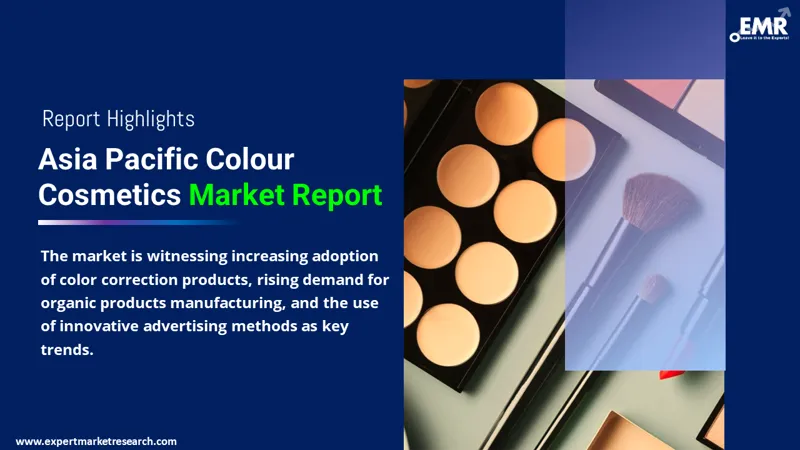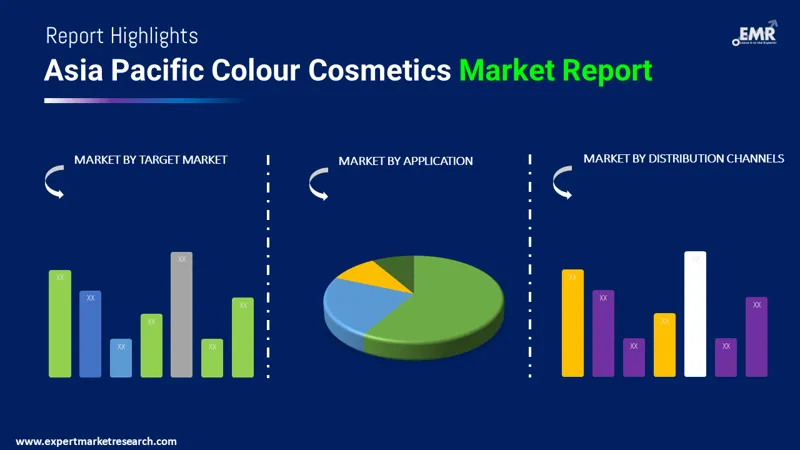
Consumer Insights
Uncover trends and behaviors shaping consumer choices today
Procurement Insights
Optimize your sourcing strategy with key market data
Industry Stats
Stay ahead with the latest trends and market analysis.
The market size for colour cosmetics in the Asia Pacific reached a value of more than USD 3.66 Billion in 2025. The Asia Pacific colour cosmetics market is expected to grow at a CAGR of 7.90% between 2026 and 2035, reaching a value of USD 7.83 Billion by 2035.
Base Year
Historical Period
Forecast Period
Compound Annual Growth Rate
7.9%
Value in USD Billion
2026-2035
*this image is indicative*
Colour cosmetics are personal care products used to enhance the outer appearance of an individual. The final formulation of the colour is given to the cosmetics with the help of pigments which are of two types; absorption pigments which impart colour by absorbing some part of the visible light spectrum, and interference pigments which manipulate light.

Read more about this report - REQUEST FREE SAMPLE COPY IN PDF
The EMR’s report titled “Asia Pacific Colour Cosmetics Market Report and Forecast 2026-2035" offers a detailed analysis of the market based on the following segments:
Market Breakup by Target Market
Market Breakup by Application
Market Breakup by Distribution Channels
Market Breakup by Region

Read more about this report - REQUEST FREE SAMPLE COPY IN PDF
Mass product is usually defined by the price point and have a larger share of the Asia Pacific colour cosmetics market because they are easily accessible, familiar to the consumers, and affordable especially to students and people with low purchasing power. Prestige products on the other hand are defined by high price and status of the product. They are usually found in the high-end specialty stores selling quality brands. The market share of prestige products is expected to grow in the coming years, due to the rising preference of consumers towards investing in high quality products.
The applications of colour cosmetics have steadily expanded to incorporate multiple areas of the body, including overall facial skin, lips, eyes, and nails. Facial make-up products hold a significant share of the Asia Pacific colour cosmetics market because of the use of foundations, concealers, blush, compact, primers, contours, and highlighters. A lot of people use these products to hide the facial marks or dark circles and to provide a clear base to their face. Men are also experimenting with facial make-up that looks natural and enhances their appearance.
Other popular colour cosmetics based on application are lip products, due to their extensive use historically, low cost, and ability to instantly brighten up a face. The segment for eye products is also expected to witness growth in the colour cosmetics market, driven by social media popularity and increasing awareness.
The comprehensive EMR report provides an in-depth assessment of the market based on the Porter's five forces model along with giving a SWOT analysis. The report gives a detailed analysis of the following key players in the Asia Pacific colour cosmetics market, covering their competitive landscape and latest developments like mergers, acquisitions, investments and expansion plans.
Unilever Plc founded in 1929 has its headquarter in London, United Kingdom. It is a multinational company that manufactures and supplies consumer goods such as food, beauty products, condiments, personal care, and cleaning agents.
L’Oréal Group was established in 1909 and is based out of Clichy, France. It is one of the largest French cosmetics companies that manufactures personal care and beauty products including make-up, skin care, hair care, sun protection, and perfume, among other products.
Kao Corporation founded in 1887 has its headquarter located in Tokyo, Japan. It is a cosmetics and chemicals company which manufactures products with the hope of contributing to the achievement of sustainable goals for a better future.
*Please note that this is only a partial list; the complete list of key players is available in the full report. Additionally, the list of key players can be customized to better suit your needs.*
Other market players include Procter & Gamble Company, Estee Lauder Inc, Oriflame, Shiseido Co. Ltd., Kosé Corporation, Amorepacific Corporation, Yatsen Holding Limited, and FSN E-Commerce Ventures Nykaa Ltd, among others.




*While we strive to always give you current and accurate information, the numbers depicted on the website are indicative and may differ from the actual numbers in the main report. At Expert Market Research, we aim to bring you the latest insights and trends in the market. Using our analyses and forecasts, stakeholders can understand the market dynamics, navigate challenges, and capitalize on opportunities to make data-driven strategic decisions.*
Get in touch with us for a customized solution tailored to your unique requirements and save upto 35%!
The market size for colour cosmetics in the Asia Pacific reached a value of more than USD 3.66 Billion in 2025.
The market is expected to grow at a CAGR of 7.90% between 2026 and 2035.
The market size for Asia Pacific colour cosmetics is expected to reach a value of more than USD 7.83 Billion by 2035.
The major market drivers are population growth, increase in demand especially by females, and improved standard of living.
The key trends of the market are increasing adoption of colour correction products, organic products manufacturing, and innovative advertising methods.
Key market players include Unilever Plc, L’Oréal Group, Kao Corporation, Procter & Gamble Company, Estee Lauder Inc, Oriflame, Shiseido Co. Ltd., Kosé Corporation, Amorepacific Corporation, Yatsen Holding Limited, and FSN E-Commerce Ventures Nykaa Ltd, among others.
Colour cosmetics are colorants and products that are applied to enhance the outer appearance of an individual.
The Asia Pacific colour cosmetics market is segmented based on target market, application, distribution channel, and country.
The final formulation of the colour is given to the cosmetics with the help of pigments.
The major countries in the colour cosmetics market in the Asia Pacific are China, India, Japan, South Korea, Indonesia, Malaysia, and Australia, among others.
Explore our key highlights of the report and gain a concise overview of key findings, trends, and actionable insights that will empower your strategic decisions.
| REPORT FEATURES | DETAILS |
| Base Year | 2025 |
| Historical Period | 2019-2025 |
| Forecast Period | 2026-2035 |
| Scope of the Report |
Historical and Forecast Trends, Industry Drivers and Constraints, Historical and Forecast Market Analysis by Segment:
|
| Breakup by Target Market |
|
| Breakup by Application |
|
| Breakup by Distribution Channels |
|
| Breakup by Region |
|
| Market Dynamics |
|
| Competitive Landscape |
|
| Companies Covered |
|
Single User License
One User
USD 3,999
USD 3,599
tax inclusive*
Datasheet
One User
USD 2,499
USD 2,249
tax inclusive*
Five User License
Five User
USD 4,999
USD 4,249
tax inclusive*
Corporate License
Unlimited Users
USD 5,999
USD 5,099
tax inclusive*
*Please note that the prices mentioned below are starting prices for each bundle type. Kindly contact our team for further details.*
Flash Bundle
Small Business Bundle
Growth Bundle
Enterprise Bundle
*Please note that the prices mentioned below are starting prices for each bundle type. Kindly contact our team for further details.*
Flash Bundle
Number of Reports: 3
20%
tax inclusive*
Small Business Bundle
Number of Reports: 5
25%
tax inclusive*
Growth Bundle
Number of Reports: 8
30%
tax inclusive*
Enterprise Bundle
Number of Reports: 10
35%
tax inclusive*
How To Order

Select License Type
Choose the right license for your needs and access rights.

Click on ‘Buy Now’
Add the report to your cart with one click and proceed to register.

Select Mode of Payment
Choose a payment option for a secure checkout. You will be redirected accordingly.
Gain insights to stay ahead and seize opportunities.

Get insights & trends for a competitive edge.

Track prices with detailed trend reports.

Analyse trade data for supply chain insights.

Leverage cost reports for smart savings

Enhance supply chain with partnerships.

Connect For More Information
Our expert team of analysts will offer full support and resolve any queries regarding the report, before and after the purchase.
Our expert team of analysts will offer full support and resolve any queries regarding the report, before and after the purchase.
We employ meticulous research methods, blending advanced analytics and expert insights to deliver accurate, actionable industry intelligence, staying ahead of competitors.
Our skilled analysts offer unparalleled competitive advantage with detailed insights on current and emerging markets, ensuring your strategic edge.
We offer an in-depth yet simplified presentation of industry insights and analysis to meet your specific requirements effectively.
Share